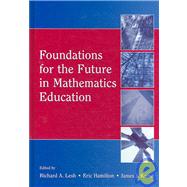
Note: Supplemental materials are not guaranteed with Rental or Used book purchases.
Purchase Benefits
Looking to rent a book? Rent Foundations for the Future in Mathematics Education [ISBN: 9780805860566] for the semester, quarter, and short term or search our site for other textbooks by Lesh; Richard A.. Renting a textbook can save you up to 90% from the cost of buying.
| Preface: Foundations for the Future in Engineering and other Fields That Are Heavy Users of Mathematics, Science and Technology | p. vii |
| What Changes are Occurring in the Kind of Problem-Solving Situations Where Mathematical Thinking Is Needed Beyond School? | p. 1 |
| The Meanings of Statistical Variation in the Context of Work | p. 7 |
| Problem-Solving and Learning in Everyday Structural Engineering Work | p. 37 |
| Modeling Without End: Conflict Across Organizational and Disciplinary Boundaries in Habitat Conservation Planning | p. 57 |
| Mathematical Modeling 'in the Wild': A Case of Hot Cognition | p. 77 |
| Learning in Design | p. 99 |
| The Cognitive Science of Mathematics: Why Is It Relevant for Mathematics Education? | p. 127 |
| What Changes Are Occurring in the Kind of Elementary-but-Powerful Mathematics Concepts That Provide New Foundations for the Future? | p. 155 |
| Models, Simulations, and Exploratory Environments: A Tentative Taxonomy | p. 161 |
| Technology Becoming Infrastructural in Mathematics Education | p. 173 |
| Why Build a Mathematical Model? Taxonomy of Situations That Create the Need for a Model to Be Developed | p. 193 |
| Cultivating Modeling Abilities | p. 201 |
| Discrete Mathematics in 21st Century Education: An Opportunity to Retreat from the Rush to Calculus | p. 211 |
| Formalizing Learning as a Complex System: Scale Invariant Power Law Distributions in Group and Individual Decision Making | p. 225 |
| Systemics of Learning for a Revised Pedagogical Agenda | p. 245 |
| The DNR System as a Conceptual Framework for Curriculum Development and Instruction | p. 263 |
| Aspects of Affect and Mathematical Modeling Processes | p. 281 |
| What Kind of Instructional Activities are Are Needed to Develop New Levels and Types of Understanding and Ability? | p. 297 |
| Beyond Efficiency: A Critical Perspective of Singapore's Educational Reforms | p. 301 |
| John Dewey Revisited-Making Mathematics Practical versus Making Practice Mathematical | p. 315 |
| The Use of Reflection Tools in Building Personal Models of Problem-Solving | p. 349 |
| Diversity-by-Design: The What, Why, and How of Generativity in Next-Generation Classroom Networks | p. 367 |
| When the Model Is a Program | p. 395 |
| Uncertainty and Iteration in Design Tasks for Engineering Students | p. 409 |
| Teacher Development in a Large Urban District and the Impact on Students | p. 431 |
| Directions for Future Research | p. 449 |
| Author Index | p. 455 |
| Subject Index | p. 463 |
| Table of Contents provided by Ingram. All Rights Reserved. |
The New copy of this book will include any supplemental materials advertised. Please check the title of the book to determine if it should include any access cards, study guides, lab manuals, CDs, etc.
The Used, Rental and eBook copies of this book are not guaranteed to include any supplemental materials. Typically, only the book itself is included. This is true even if the title states it includes any access cards, study guides, lab manuals, CDs, etc.